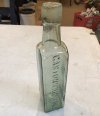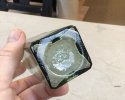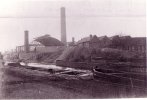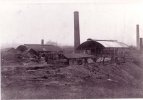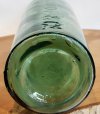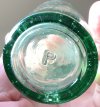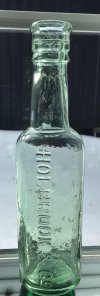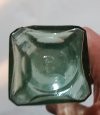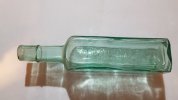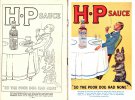Pedrocut, you are of course correct about the county boundary. However, my research leads me to believe that none of the Birmingham glass manufacturers had any particular interest in bottle making. I have listed those of which I am aware in case anybody has a contrary view. However, I still don't believe that a Birmingham glassworks would use the Stafford knot as an emblem.
Snow Hill Glassworks
1656 Mayer Oppenheim obtains patent for red & ruby flint glass
1762 Mayer Oppenheim advertises glasshouse and dealing house for sale.
1775 Mayer Oppenheim became bankrupt.
Union Glassworks, Dartmouth Street
1818 Established Bacchus, Green & Green
1822 Bacchus and Green
1833 George Bacchus & Co.
1841 George Bacchus & Sons
1851 exhibited at Great Exhibition
1860 Bacchus family sold out to Stone, Fawdry & Stone
1860 Sir Ben Stone joins firm (friend of the Richardsons)
187? Closed
Etna Flint Glass Works, Birmingham
1851 July 24th press moulded and uranium coloured plate registered by George Joseph Green.
Bagot Street Glassworks
Made flat glass
1850 purchased by Chance Brothers
1876 closed by chance brothers
Victoria Glassworks, Dartmouth Street
Run by James Stevens senior & his son James junior until about 1880
Park Glass Works, Spring Hill
1788 founded by Isaac Hawker formerly a glasscutter of Spiceal Street, then a glassmaker of 14 Edgbaston Street.
1792 death of Isaac Hawker, business continued by his son John
1803 John Hawker still working the glasshouse
1808 or earlier passed to Biddle and Lloyd (John Biddle and David Lloyd)
1822 last known reference to Biddle & Lloyd
1833 reference to John Biddle alone.
1850 Lloyd & Summerfield made coloured vases shaped like the onion family
1861 Lloyd & Summerfield apply the Siemens’ patent furnace to glass melting
Islington Glass Works, Birmingham Heath.
1799 built by Owen Johnson after his glass toy manufactory in Birmingham was destroyed by fire in 1799 (see Aris Gazette of 4 Sep 1799)
1803 Owen Johnson alone mentioned in trade directory.
1805 established partnership of Shakespear & Johnson abandons the New Town Glasshouse, Walmer lane and joined by John Berry establish themselves here.
1815, December 20th partnership dissolved. Shakespear either founded or moved to the neighbouring Soho Glassworks. Johnson & Berry take Rice Harris into partnership.
1829, May 8th Owen Johnson retires
1832 Aug 9th, John Berry leaves partnership.
1833 firm run as Rice Harris & Co.
1849 employed 400 hands.
1851 exhibited at Great Exhibition
1878/9 closed
Belmont Row Glass Works, Great Brook Street, Ashted, Aston
Established some time after 1804 when Thomas Harris left the partnership of Hughes and Harris to take up glass making. Run by partnership of Harris, Smart and Co. Partners were Thomas Harris, T. L. Hawkes, Thomas Smart and Rice Harris.
1810 Hawkes and Smart leave the firm. Thomas Harris and Rice Harris continued until 1814.
1814, November 8th Rice Harris left and was replaced by John Harris.
1819, September 7th, John Harris retires and the firm becomes Harris, Gammon & Co. (probably Thomas Harris, William Gammon and Thomas Lowe).
T Harris eventually died or retired and the firm became William Gammon & Co.
1832 Thomas Lowe retired, business continued by William Gammon
1833 William Gammon & Co mentioned.
Broad Street Glasshouse
1832 Messrs A. F. Osler and T.C. Osler moves established family firm of glasscutters to Broad Street
1849 exhibited at Birmingham Exhibition
Icknield Glassworks, Freeth Street, Rotton Park
1850 F & C Osler take Edward Page as partner and move to purpose-built glasshouse on the bank of the old Birmingham Canal.
1851 produced glass fountain centrepiece for the great exhibition
1855 F & C Osler were sole owners
1882 F & C Osler made etagere now in Birmingham Museum
1922 closed.
Hands Glassworks, Lodge Road, Hockley
Crystal and coloured glass
1930 closed
Soho & Vesta Glass Works, Lodge Road, Hockley
1816 William Shakespear left the Islington glassworks and took into partnership Thomas Fletcher to build or buy the Soho works.
1822 Thomas Fletcher left the firm.
1833 run as Hannah Shakespear & Co.
1850 John Walsh Walsh purchased factory from Samuel Shakespear
1882 Lewis John Murray joins as manager
1951 closed
Isaac Barnes
1855-75 Cambridge Street, Broad Street, Summer Row
Barr Street, Great Hampton Row, Hockley
Francis Barnes
Coloured glass
1858 Closed
Warstone Lane, Hockley
G.H. Barnes
Closed 1890
Hampton Street Glassworks
1865 established by Thomas Lane
Great Brook Street, Glasshouse, Aston
1829-1887 W. Gammon & Son
Toledo Glassworks, Aston Brook Street, Aston
Parkes & Saunders
Spon Lane Glassworks, Smethwick
1814 British Crown Glass Company formed by Thomas and Philip Palmer, Nathaniel Chater and Samuel Brookes
1822 October 17th Thomas Shutt died.
1824 purchased by Lucas Chance
1832 sheet glass introduced by Lucas Chance.
1840 invented paper-thin glass for microscopy
1847 Chances adopt new method of making rolled plate-glass.
1851 shown on ordnance survey as British Glass Works
1851 built a lighthouse works in the site
Birmingham Plate Glass (Gibbins), Smethwick
1877 closed by Chance Brothers
Halesowen Street Glassworks, Oldbury
Manufactured antique-glass for most of 19th Century.


